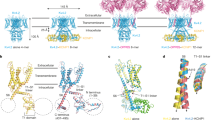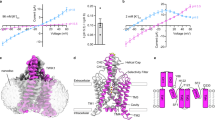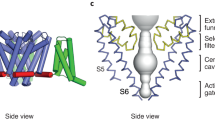Abstract
We report the first example of a K+ channel β-subunit that is also a serine/threonine kinase. MPS-1 is a single–transmembrane domain protein that coassembles with voltage-gated K+ channel KVS-1 in the nervous system of the nematode Caenorhabditis elegans. Biochemical analysis shows that MPS-1 can phosphorylate KVS-1 and other substrates. Electrophysiological analysis in Chinese hamster ovary (CHO) cells demonstrates that MPS-1 activity leads to a significant decrease in the macroscopic current. Single-channel analysis and biotinylation assays indicate that MPS-1 reduces the macroscopic current by lowering the open probability of the channel. These data are consistent with a model that predicts that the MPS-1–dependent phosphorylation of KVS-1 sustains cell excitability by controlling K+ flux.
This is a preview of subscription content, access via your institution
Access options
Subscribe to this journal
Receive 12 print issues and online access
$209.00 per year
only $17.42 per issue
Buy this article
- Purchase on Springer Link
- Instant access to full article PDF
Prices may be subject to local taxes which are calculated during checkout







Similar content being viewed by others
References
MacKinnon, R. Determination of the subunit stoichiometry of a voltage-activated potassium channel. Nature 350, 232–235 (1991).
Doyle, D. et al. The structure of the potassium channel: molecular bases for K+ conduction and selectivity. Science 280, 69–77 (1998).
Abbott, G. & Goldstein, S. A superfamily of small potassium channel subunits: form and function of the MinK-related peptides (MiRPs). Q. Rev. Biophys. 31, 357–398 (1998).
McCrossan, Z.A. & Abbott, G.W. The MinK-related peptides. Neuropharmacology 47, 787–821 (2004).
Wang, Y., Park, K.H., Hernandez, L., Cai, S.-Q. & Sesti, F. Biophysical and biomedical aspects of KCNE potassium channel ancillary subunits. in Recent Research Developments in Biophysics Vol. 3 Part II (ed. Pandalai, S.G.) 351–363 (Transworld Research Network, Trivandrum, India, 2004).
Park, K.H., Hernandez, L., Cai, S.Q., Wang, Y. & Sesti, F. A Family of K+ Channel Ancillary Subunits Regulate Taste Sensitivity in Caenorhabditis elegans. J. Biol. Chem. 280, 21893–21899 (2005).
Anantharam, A. et al. RNA interference reveals that endogenous Xenopus MinK-related peptides govern mammalian K+ channel function in oocyte expression studies. J. Biol. Chem. 278, 11739–11745 (2003).
Takumi, T., Ohkubo, H. & Nakanishi, S. Cloning of a membrane protein that induces a slow voltage-gated potassium current. Science 242, 1042–1045 (1988).
Tai, K. & Goldstein, S. The conduction pore of a cardiac potassium channel. Nature 391, 605–608 (1998).
Melman, Y.F., Um, S.Y., Krumerman, A., Kagan, A. & McDonald, T.V. KCNE1 binds to the KCNQ1 pore to regulate potassium channel activity. Neuron 42, 927–937 (2004).
Chen, H., Sesti, F. & Goldstein, S.A. Pore- and state-dependent cadmium block of I(Ks) channels formed with MinK-55C and wild-type KCNQ1 subunits. Biophys. J. 84, 3679–3689 (2003).
Sesti, F. & Goldstein, S.A. Single-channel characteristics of wild-type IKs channels and channels formed with two minK mutants that cause long QT syndrome. J. Gen. Physiol. 112, 651–663 (1998).
Sesti, F., Tai, K.K. & Goldstein, S.A. MinK endows the I(Ks) potassium channel pore with sensitivity to internal tetraethylammonium. Biophys. J. 79, 1369–1378 (2000).
Yang, Y. & Sigworth, F.J. Single-channel properties of IKs potassium channels. J. Gen. Physiol. 112, 665–678 (1998).
Pusch, M. Increase of the single-channel conductance of KvLQT1 potassium channels induced by the association with minK. Pflugers Arch. 437, 172–174 (1998).
Marx, S.O. et al. Requirement of a macromolecular signaling complex for beta adrenergic receptor modulation of the KCNQ1-KCNE1 potassium channel. Science 295, 496–499 (2002).
Kurokawa, J., Chen, L. & Kass, R.S. Requirement of subunit expression for cAMP-mediated regulation of a heart potassium channel. Proc. Natl. Acad. Sci. USA 100, 2122–2127 (2003).
McCrossan, Z.A. et al. MinK-related peptide 2 modulates Kv2.1 and Kv3.1 potassium channels in mammalian brain. J Neurosci. 3;23, 8077–91 (2003).
Splawski, I., Tristani-Firouzi, M., Lehmann, M.H., Sanguinetti, M.C. & Keating, M.T. Mutations in the hMinK gene cause long QT syndrome and suppress IKs function. Nat. Genet. 17, 338–340 (1997).
Piccini, M. et al. KCNE1-like gene is deleted in AMME contiguous gene syndrome: identification and characterization of the mouse homologues. Genomics 60, 251–257 (1999).
Abbott, G. et al. MiRP2 forms potassium channels in skeletal muscle with Kv3.4 and is associated with periodic paralysis. Cell 104, 217–231 (2001).
Abbott, G. et al. MiRP1 forms IKr potassium channels with HERG and is associated with cardiac arrhythmia. Cell 97, 175–187 (1999).
Sesti, F. et al. A common polymorphism associated with antibiotic-induced cardiac arrhythmia. Proc. Natl. Acad. Sci. USA 97, 10613–10618 (2000).
Splawski, I. et al. Spectrum of mutations in long-QT syndrome genes. KVLQT1, HERG, SCN5A, KCNE1, and KCNE2. Circulation 102, 1178–1185 (2000).
Manning, G., Whyte, D.B., Martinez, R., Hunter, T. & Sudarsanam, S. The protein kinase complement of the human genome. Science 298, 1912–1934 (2002).
Bianchi, L., Kwok, S.M., Driscoll, M. & Sesti, F. A potassium channel-MiRP complex controls neurosensory function in Caenorhabditis elegans. J. Biol. Chem. 278, 12415–12424 (2003).
Hwang, I-S., Kim, J-H. & Choi, M-U. Kinetic study of dephosphoryltation of Myelin Basic Protein by some protein phosphates. Bull. Korean Chem. Soc. 18, 428–432 (1997).
Miyamoto, E. & Kakiuchi, S. In vitro and in vivo phosphorylation of myelin basic protein by exogenous and endogenous adenosine 3′:5′-monophosphate-dependent protein kinases in brain. J. Biol. Chem. 249, 2769–2777 (1974).
Laurino, J., Colca, J., Pearson, J., DeWald, D. & McDonald, J. The in vitro phosphorylation of calmodulin by the insulin receptor tyrosine kinase. Arch. Biochem. Biophys. 265, 8–21 (1988).
Tonks, N., Diltz, C. & Fischer, E. CD45, an integral membrane protein tyrosine phosphatase. Characterization of enzyme activity. J. Biol. Chem. 265, 10674–10680 (1990).
Ryazanova, L.V., Dorovkov, M.V., Ansari, A. & Ryazanov, A.G. Characterization of the protein kinase activity of TRPM7/ChaK1, a protein kinase fused to the transient receptor potential ion channel. J. Biol. Chem. 279, 3708–3716 (2004).
Beeton, C.A., Chance, E.M., Foukas, L.C. & Shepherd, P.R. Comparison of the kinetic properties of the lipid- and protein-kinase activities of the p110alpha and p110beta catalytic subunits of class-Ia phosphoinositide 3-kinases. Biochem. J. 350, 353–359 (2000).
Rintamaki, E. et al. Phosphorylation of light-harvesting complex II and photosystem II core proteins shows different irradiance-dependent regulation in vivo. Application of phosphothreonine antibodies to analysis of thylakoid phosphoproteins. J. Biol. Chem. 272, 30476–30482 (1997).
Zheng, B. et al. The mPer2 gene encodes a functional component of the mammalian circadian clock. Nature 400, 169–173 (1999).
Du, P. et al. Phosphorylation of serine residues in histidine-tag sequences attached to recombinant protein kinases: a cause of heterogeneity in mass and complications in function. Protein Expr. Purif. published online 7 June 2005 (10.1016/j.pep.2005.04.018).
Sigworth, F.J. The variance of sodium current fluctuations at the node of Ranvier. J. Physiol. (Lond.) 307, 97–129 (1980).
Ryazanov, A.G., Pavur, K.S. & Dorovkov, M.V. Alpha-kinases: a new class of protein kinases with a novel catalytic domain. Curr. Biol. 9, R43–R45 (1999).
Runnels, L.W., Yue, L. & Clapham, D.E. TRP-PLIK, a bifunctional protein with kinase and ion channel activities. Science 291, 1043–1047 (2001).
Drennan, D. & Ryazanov, A.G. Alpha-kinases: analysis of the family and comparison with conventional protein kinases. Prog. Biophys. Mol. Biol. 85, 1–32 (2004).
Barhanin, J. et al. K(V)LQT1 and lsK (minK) proteins associate to form the I(Ks) cardiac potassium current. Nature 384, 78–80 (1996).
Schroeder, B. et al. A constitutively open potassium channel formed by KCNQ1 and KCNE3. Nature 403, 196–199 (2000).
Melman, Y.F., Domenech, A., de la Luna, S. & McDonald, T.V. Structural determinants of KvLQT1 control by the KCNE family of proteins. J. Biol. Chem. 276, 6439–6444 (2001).
Ward, S. Chemotaxis by the nematode Caenorhabditis elegans: identification of attractants and analysis of the response by use of mutants. Proc. Natl. Acad. Sci. USA 70, 817–821 (1973).
Bargmann, C. & Mori, I. in C. elegans II (eds. Riddle, D.L., Blumenthal, T., Meyer, B.T. & Priess, J.R.) Ch. 25 717–37 (Cold Spring Harbor Laboratory Press, Cold Spring Harbor, New York, 1997).
Bargmann, C.I. & Horvitz, H.R. Chemosensory neurons with overlapping functions direct chemotaxis to multiple chemicals in C. elegans. Neuron 7, 729–742 (1991).
Sakmann, B. & Neher, E. (eds) Single-Channel Recording (Plenum Press, New York and London, 1995).
Acknowledgements
We thank L. Runnels, A. Ryazanov and J. Lenard for their comments on the manuscript and Fulvio Sesti for help with the graphics. This work was supported by grant R01GM68581-01 from the US National Institutes of Health to F.S.
Author information
Authors and Affiliations
Corresponding author
Ethics declarations
Competing interests
The authors declare no competing financial interests.
Rights and permissions
About this article
Cite this article
Cai, SQ., Hernandez, L., Wang, Y. et al. MPS-1 is a K+ channel β-subunit and a serine/threonine kinase. Nat Neurosci 8, 1503–1509 (2005). https://doi.org/10.1038/nn1557
Received:
Accepted:
Published:
Issue Date:
DOI: https://doi.org/10.1038/nn1557
This article is cited by
-
Auto-phosphorylation of a voltage-gated K+ channel controls non-associative learning
The EMBO Journal (2009)
-
Non-conducting functions of voltage-gated ion channels
Nature Reviews Neuroscience (2006)
-
Signaling protein complexes associated with neuronal ion channels
Nature Neuroscience (2006)
-
From molecule to malady
Nature (2006)



